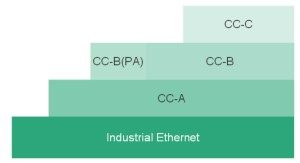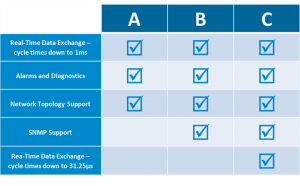In this article, we will cover conformance classes, as they fit into the mandatory features of PROFINET.
CC-A, CC-B, CC-C
 Every PROFINET device has a defined set of features which are mandatory based on its conformance class. The conformance classes are divided into three categories, class A, B, and C. Conformance Class A (CC-A) is the most basic while C (CC-C) is the most advanced and it should be noted that they build upon each other, so Class C also contains all functions from Class B and A. For example the simplest “Class A”, provides real time and acyclic real time, as well as support for standard TCP/IP and basic functions such as topology information. CC-B adds in simple network management protocol (SNMP) support to make it possible to read statistics with standard SNMP tools. And finally, for the most demanding applications, there is Conformance Class C which has support for motion control applications with a jitter of less than a microsecond and distributed clock synchronization protocol (allowing deterministic Ethernet).
Every PROFINET device has a defined set of features which are mandatory based on its conformance class. The conformance classes are divided into three categories, class A, B, and C. Conformance Class A (CC-A) is the most basic while C (CC-C) is the most advanced and it should be noted that they build upon each other, so Class C also contains all functions from Class B and A. For example the simplest “Class A”, provides real time and acyclic real time, as well as support for standard TCP/IP and basic functions such as topology information. CC-B adds in simple network management protocol (SNMP) support to make it possible to read statistics with standard SNMP tools. And finally, for the most demanding applications, there is Conformance Class C which has support for motion control applications with a jitter of less than a microsecond and distributed clock synchronization protocol (allowing deterministic Ethernet).
Available Functions
PROFINET conformance classes make it simpler to evaluate what device or controller functions are available and mandatory for the target application by users. And this helps guide you in the product selection process when it comes to picking the products and talking with the vendors (visit PI’s online product guide to find current products). For product managers or developers, conformance classes help determine which requirements and functions must be met or are necessary in order to release the product to the intended market space and we’ve got a more detailed post about that in the developer section. For example, what testing is required for device certification or what services are required (or optional) for a certain application or industry,for example, a process application in a chemical plant or a motion control application.
In the attached figure (click to expand), you can also see an overview of what functions are necessary for each conformance class.
We describe the optional services and functions which are available in the next lesson.
For further study:
To get into details for developers, more information is in the full conformance classes document and in the latest profiles specification for PROFINET devices (recommended).

 For more information, download the full White Paper:
For more information, download the full White Paper: